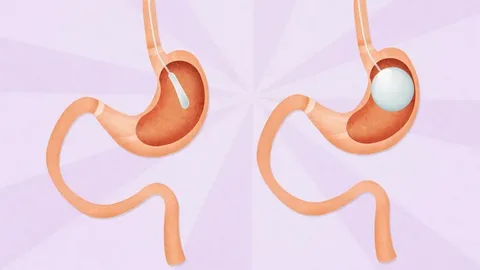Understanding the Gastric Balloon Procedure
The gastric balloon procedure is an innovative, minimally invasive weight loss method that aids individuals struggling with obesity. The procedure involves the insertion of a deflated balloon into the stomach through the esophagus, following which it is inflated with saline solution. This inflatable device occupies space in the stomach, creating a sensation of fullness, which helps in reducing food intake. Typically, the procedure is performed under sedation and can be completed within 30 minutes to an hour.
Eligibility for the gastric balloon procedure generally includes individuals with a body mass index (BMI) of 30 or higher who have been unable to achieve sustainable weight loss through traditional methods. It is particularly suitable for those seeking to lose weight before undergoing more invasive surgeries, such as gastric bypass or sleeve gastrectomy. However, individuals with certain medical conditions, such as severe gastroesophageal reflux disease or a history of gastric surgery, may not be suitable candidates.
There are several types of gastric balloons available, with variations designed to cater to different patient needs. Some of the most common options include the Orbera balloon, the Reshape Duo balloon, and the Elipse balloon. The choice of balloon will be determined during consultations with healthcare professionals, who will assess factors such as the patient’s medical history and weight loss goals. Following implantation, the balloon is usually kept in place for six months to a year, during which regular follow-up appointments are scheduled to monitor progress and ensure patient safety.
Prior to the procedure, potential candidates undergo comprehensive evaluations, including blood tests and consultations with bariatric specialists and nutritionists. These assessments are crucial for identifying potential risks and establishing a tailored weight loss plan that complements the gastric balloon procedure. Overall, the gastric balloon offers a head start for patients on their weight loss journey, but careful consideration and professional guidance are essential for optimal outcomes.
The Benefits of Choosing a Gastric Balloon
The gastric balloon emerges as an innovative and effective solution for individuals seeking to embark on their weight loss journey. One of the most notable benefits is its non-surgical nature, which significantly reduces the risks and recovery times often associated with traditional weight loss surgeries. The procedure involves the endoscopic insertion of a deflated balloon into the stomach, which is then filled with saline to promote a feeling of satiety. This approach allows patients to avoid the lengthy preparation and recovery times required for surgical interventions.
Moreover, clinical studies indicate that patients can expect substantial weight loss outcomes, often shedding between 20 to 60 pounds within a six-month period. This targeted intervention allows individuals to experience early success in their weight loss efforts, which can create a positive feedback loop that encourages continued commitment to healthier lifestyle choices. With an initial weight loss, many patients report tangible improvements in issues related to obesity, including conditions such as diabetes, hypertension, and sleep apnea. These health improvements not only enhance the quality of life but can also lead to a reduced dependency on medications.
Additionally, the psychological benefits associated with a gastric balloon cannot be overlooked. As patients witness the progressive results of their efforts, they often experience a significant boost in self-esteem and motivation. This newfound confidence can play a crucial role in sustaining long-term weight loss and achieving a healthier lifestyle overall. The combination of physical and psychological gains from the gastric balloon can provide a comprehensive framework for individuals to reclaim their health and pursue a more active and fulfilling life.
Lifestyle Changes and Support During Weight Loss
For individuals considering the gastric balloon procedure as a tool for weight loss, embracing essential lifestyle changes is critical to achieve sustainable results. This intervention, while effective in initiating weight loss, should ideally be complemented by a well-rounded approach that includes dietary modifications, exercise routines, and a strong support system. By prioritizing these elements, individuals can significantly enhance the effectiveness of the gastric balloon and ensure lasting weight loss success.
Primarily, dietary changes are fundamental in creating a calorie deficit necessary for weight loss. Individuals are advised to adopt a balanced diet focused on whole foods such as fruits, vegetables, lean proteins, and whole grains. Limiting processed foods, sugars, and high-calorie beverages is also essential. These dietary adjustments not only facilitate weight loss but also help in developing healthier eating habits that can be sustained long-term. Consulting with a nutritionist can provide personalized meal plans and guidance, ensuring that individuals meet their nutritional needs while on their weight loss journey.
In addition to dietary modifications, incorporating regular physical activity is crucial for enhancing overall health and expediting weight loss. Developing a consistent exercise routine that includes both aerobic and strength-training activities can promote fat loss, improve metabolism, and strengthen muscles. It is recommended that individuals find enjoyable forms of exercise to increase adherence and motivation. Whether it’s joining a local fitness class, engaging in outdoor activities, or utilizing home workout programs, staying active is paramount.
Finally, the importance of ongoing support cannot be overstated. Continuous encouragement from healthcare providers, nutritionists, and support groups plays a significant role in maintaining motivation. Regular check-ins with these professionals can help individuals address challenges promptly and celebrate milestones, fostering a sense of community and commitment. Personal accountability and motivation are indispensable in this transformative journey towards healthier living.
Potential Risks and Considerations
The gastric balloon is a non-surgical weight loss option that offers individuals the potential for significant weight reduction. However, like any medical procedure, it comes with its share of risks and considerations that must be thoroughly understood before proceeding. One of the most critical aspects is the possibility of complications during the procedure or shortly after the gastric balloon is placed. Common issues include nausea, vomiting, and abdominal discomfort. These symptoms may be temporary, but they can also indicate a more serious complication, such as balloon deflation or gastrointestinal obstruction. It is crucial for potential patients to be aware of these risks and to discuss them in detail with a healthcare provider.
Recognizing symptoms of adverse effects is essential for ensuring safety and effectiveness. Patients should be vigilant for signs such as severe pain, persistent vomiting, or any sudden changes in bowel habits, as these may require immediate medical attention. Moreover, follow-up appointments with healthcare professionals are vital in monitoring progress and addressing any complications that may arise post-procedure.
Another important consideration is the long-term commitment required following the removal of the gastric balloon. While the balloon can provide an initial boost in weight loss, it is not a permanent solution. After the balloon is removed, individuals must adopt healthy lifestyle changes, including proper diet and exercise routines, to maintain their weight loss. Failing to develop these habits can lead to the risk of weight regain, undermining the benefits gained during the gastric balloon treatment. Consequently, patients must evaluate their readiness for this lifestyle transformation and understand the importance of ongoing support and resources to achieve lasting weight loss success.






